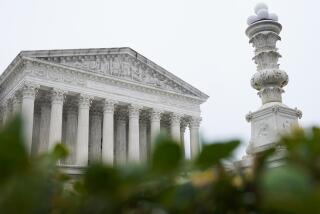Ruling out race in college admissions: How far will high court go?
WASHINGTON — The Supreme Court’s conservative justices seemed inclined Wednesday to strike down a University of Texas affirmative action plan, but did not make it clear how far they might go in outlawing the use of race in admissions at all colleges and universities.
In his opening question, Chief Justice John G. Roberts noted that applicants to the University of Texas must check a box to certify their race or ethnicity.
Roberts asked whether a student who is one-fourth Hispanic would qualify as a minority. When the attorney for Texas said the student could decide for himself, Roberts asked: How about one-eighth? The chief justice made clear throughout the argument that he is troubled by the use of race as a deciding factor in public policies.
Since 2006 the court has had five justices who are skeptical of affirmative action. But Wednesday marked the first time since then that the high court has heard a constitutional challenge to affirmative action in higher education.
Justice Samuel Alito, who replaced the retiring Justice Sandra Day O’Connor in 2006, said he was surprised to learn that the Texas university seeks black and Latino students who grew up in affluent families with professional parents. Alito said he assumed affirmative action was designed to give a preference to students from “underprivileged backgrounds,” not for minority students from wealthy families.
He was referring to a passage in the University of Texas brief that said the university may wish to give a preference to a black student with professional parents and from a good Dallas area high school over a black or Latino student who earned top grades at an “overwhelmingly” black or Latino high school.
Under the “top 10%” law adopted by the Texas Legislature, the university must admit the top graduates from all of its high schools. That policy has succeeded in steadily raising the percentage of Latino and black students. But the university decided in 2004 to adopt a new affirmative action policy and to seek qualified minority students who did not graduate in the top 10% of their high schools.
Alito said he did not understand why the university would give a preference to the minority student from a wealth family over a white or Asian student with good grades and test scores but who came from a middle-class family.
Gregory Garre, the Washington attorney for the University of Texas, said the minority student from an integrated suburban high school could contribute more to the diversity on campus.
“You are saying what counts is race above all else,” said Justice Anthony M. Kennedy, who is likely to cast the decisive vote in the case.
Joined by Justices Antonin Scalia and Clarence Thomas, Kennedy and the court’s conservative bloc could write an opinion that strikes down the Texas approach and puts new limits on affirmative action in colleges and universities.
But the hourlong argument gave little hint as to how far the opinion would go. In the past, Kennedy has agreed with universities’ need to seek racial diversity on campus, but he also said they should use “race neutral” policies whenever possible.
Bert Rein, the attorney for Abigail Fisher, a rejected white student, sounded that theme. He said there was no need for a race-based affirmative-action policy at the University of Texas since about one-fourth of its new students are Latino or black as a result of the “top 10%” law.
Using race as an admission criteria “should have been a last resort, not a first resort,” Rein said. And since Texas has achieved considerable diversity on campus, it did not need to adopt an extra affirmative action policy, he argued.
U.S. Solicitor General Donald Verrilli Jr. cautioned the justices about reversing course on affirmative action. He said colleges and universities have adopted admission policies that allow for a limited consideration of race based on the court’s past rulings.
College officials should be allowed the “flexibility” to design admissions policies that bring a diverse group of students to their campuses, he said.
But Rein countered that college officials think they have a “green light” to pick students based on their race. It is time, he said in his concluding comments, for the court to stop “the unchecked use of race” in university admissions.
It will probably be several months before the court hands down an opinion in the case of Fisher vs. University of Texas.
Only eight justices will decide, since Justice Elena Kagan withdrew. The three liberal justices spent part of the argument time suggesting the court should thrown out Fisher’s case because she had already graduated from Louisiana State University.
ALSO:
Kids in solitary confinement: ‘Cruel, harmful,’ groups say
1 dead, two still trapped in parking garage collapse in Miami
Coldcocked: ‘Random’ attack on teacher is caught on tape [Video]
More to Read
Sign up for Essential California
The most important California stories and recommendations in your inbox every morning.
You may occasionally receive promotional content from the Los Angeles Times.











